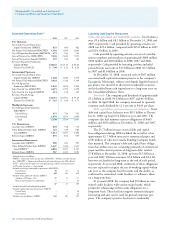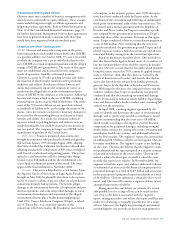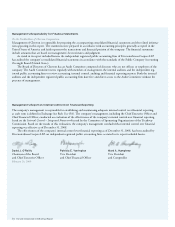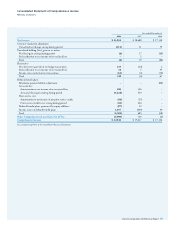Chevron 2008 Annual Report Download - page 51
Download and view the complete annual report
Please find page 51 of the 2008 Chevron annual report below. You can navigate through the pages in the report by either clicking on the pages listed below, or by using the keyword search tool below to find specific information within the annual report.Chevron Corporation 2008 Annual Report 49
reasonably estimated. The liability balance of approximately
$9.4 billion for asset retirement obligations at year-end 2008
related primarily to upstream properties.
For the company’s other ongoing operating assets, such as
refineries and chemicals facilities, no provisions are made for
exit or cleanup costs that may be required when such assets
reach the end of their useful lives unless a decision to sell or
otherwise abandon the facility has been made, as the inde-
terminate settlement dates for the asset retirements prevent
estimation of the fair value of the asset retirement obligation.
Refer also to Note 24, beginning on page 89, related
to FAS 143 and the company’s adoption in 2005 of FASB
Interpretation No. (FIN) 47, Accounting for Conditional Asset
Retirement Obligations – An Interpretation of FASB Statement
No. 143 (FIN 47), and the discussion of “Environmental
Matters” below.
Income Taxes The company calculates its income tax
expense and liabilities quarterly. These liabilities generally are
subject to audit and are not finalized with the individual tax-
ing authorities until several years after the end of the annual
period for which income taxes have been calculated. Refer to
Note 16 beginning on page 76 for a discussion of the
periods for which tax returns have been audited for the com-
pany’s major tax jurisdictions and a discussion for all tax
jurisdictions of the differences between the amount of tax
benefits recognized in the financial statements and the
amount taken or expected to be taken in a tax return. The
company does not expect that settlement of income tax liabil-
ities associated with uncertain tax positions will have a
material effect on its results of operations, consolidated finan-
cial position or liquidity.
The Emergency Economic Stabilization Act of 2008,
which contained a number of energy and tax-related provi-
sions, known as the Energy Improvement and Extension Act
of 2008 (the Act), was signed into U.S. law in October 2008.
The Act includes two provisions that affect Chevron’s tax lia-
bility, beginning in the fourth quarter of 2008. The Act
freezes at 6 percent the domestic manufacturer’s deduction
on income from U.S. oil and gas operations that was sched-
uled to increase to 9 percent in 2010. Effective in 2009, the
Act expands the current foreign tax credit (FTC) limitation
for Foreign Oil and Gas Extraction Income to also include
foreign downstream income, known as Foreign Oil Related
Income. This change is expected to impact Chevron’s utiliza-
tion of FTCs.
Suspended Wells The company suspends the costs of
exploratory wells pending a final determination of the com-
mercial potential of the related crude oil and natural gas
fields. The ultimate disposition of these well costs is depen-
dent on the results of future drilling activity or development
decisions or both. At December 31, 2008, the company had
approximately $2.1 billion of suspended exploratory wells
included in properties, plant and equipment, an increase
of $458 million from 2007. The 2007 balance reflected an
increase of $421 million from 2006.
The future trend of the company’s exploration expenses
can be affected by amounts associated with well write-offs,
including wells that had been previously suspended pend-
ing determination as to whether the well had found reserves
that could be classified as proved. The effect on exploration
expenses in future periods of the $2.1 billion of suspended
wells at year-end 2008 is uncertain pending future activities,
including normal project evaluation and additional drilling.
Refer to Note 20, beginning on page 79, for addi-
tional discussion of suspended wells.
Equity Redetermination For oil and gas producing
operations, ownership agreements may provide for periodic
reassessments of equity interests in estimated crude oil and
natural gas reserves. These activities, individually or together,
may result in gains or losses that could be material to earnings
in any given period. One such equity redetermination process
has been under way since 1996 for Chevron’s interests in four
producing zones at the Naval Petroleum Reserve at Elk Hills,
California, for the time when the remaining interests in these
zones were owned by the U.S. Department of Energy. A wide
range remains for a possible net settlement amount for the
four zones. For this range of settlement, Chevron estimates
its maximum possible net before-tax liability at approximately
$200 million, and the possible maximum net amount that
could be owed to Chevron is estimated at about $150 million.
The timing of the settlement and the exact amount within
this range of estimates are uncertain.
Other Contingencies Chevron receives claims from and
submits claims to customers; trading partners; U.S. federal,
state and local regulatory bodies; governments; contractors;
insurers; and suppliers. The amounts of these claims, indi-
vidually and in the aggregate, may be significant and take
lengthy periods to resolve.
The company and its affiliates also continue to review
and analyze their operations and may close, abandon, sell,
exchange, acquire or restructure assets to achieve operational
or strategic benefits and to improve competitiveness and prof-
itability. These activities, individually or together, may result
in gains or losses in future periods.
Environmental Matters
Virtually all aspects of the businesses in which the company
engages are subject to various federal, state and local envi-
ronmental, health and safety laws and regulations. These
regulatory requirements continue to increase in both number
and complexity over time and govern not only the manner
in which the company conducts its operations, but also the
products it sells. Most of the costs of complying with laws
and regulations pertaining to company operations and prod-
ucts are embedded in the normal costs of doing business.
Accidental leaks and spills requiring cleanup may occur
in the ordinary course of business. In addition to the costs
for environmental protection associated with its ongoing
operations and products, the company may incur expenses
for corrective actions at various owned and previously owned
facilities and at third-party-owned waste-disposal sites used
by the company. An obligation may arise when operations are
closed or sold or at non-Chevron sites where company products
have been handled or disposed of. Most of the expenditures to
fulfill these obligations relate to facilities and sites where past
operations followed practices and procedures that were con-
























